The priceless footage of Amundsen’s successful attempt to reach the South Pole, this material was meant to accompany the explorer’s lectures. We get ships, ice and penguins.
Baby, it’s cold outside
“I may say that this is the greatest factor—the way in which the expedition is equipped—the way in which every difficulty is foreseen, and precautions taken for meeting or avoiding it. Victory awaits him who has everything in order—luck, people call it. Defeat is certain for him who has neglected to take the necessary precautions in time; this is called bad luck.”
—Roald Amundsen
A huge thanks to Anders in Norway for helping me obtain the DVD set of the Amundsen exploration! It was much appreciated.
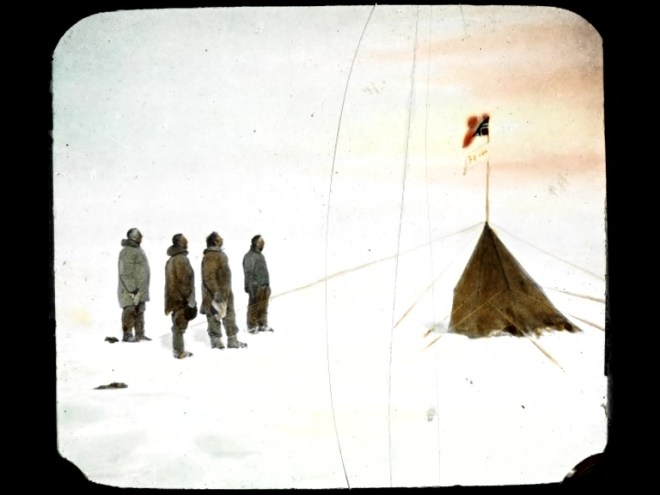
Before starting this review, I should get this out of the way: I am Team Amundsen. I admire his preparedness and determination and grit but agree that he was a deeply flawed man. He reached the South Pole because he planned well and had a strong team that knew what it was doing. I say this because the Amundsen vs. Scott debate can still get heated in this day and age and there is really no way to talk about one man’s polar attempt without discussing the other. Comparisons are inevitable and necessary; we can no more avoid them than a space historian can avoid comparing the Soviets and Americans.
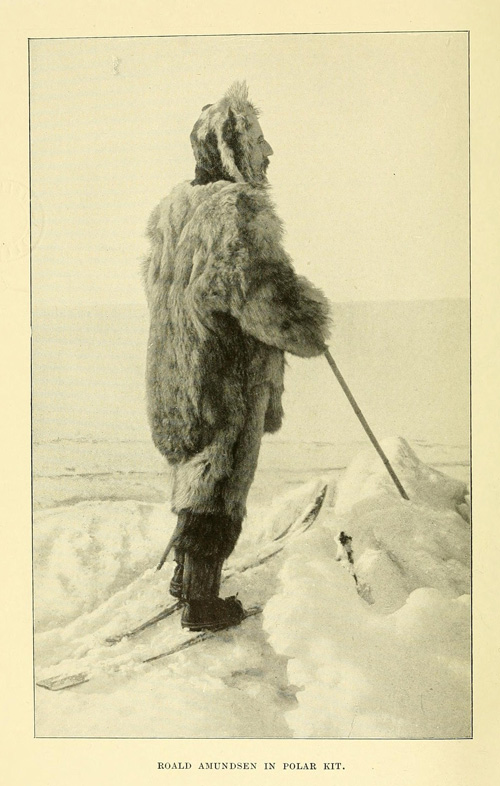
Finally, I must also issue a trigger warning. All material related to arctic exploration is pretty intense and neither man nor dog had it easy. People die. Animals die. It’s harsh stuff and it’s harsh in unexpected ways. While I will not be dwelling on these details, there is disturbing material ahead so I recommend getting out now if you feel this might be too upsetting.
For this review, I am most grateful for Amundsen’s memoirs, My Life as an Explorer and The South Pole volumes one and two. These books are available for free reading online.

In addition, I relied heavily on the diaries of Roald Amundsen and Olav Bjaaland, the master skier who accompanied him to the South Pole. They were published together with the diary of Captain Robert Falcon Scott in Race for the South Pole: The Expedition Diaries of Scott and Amundsen with explanatory text by Roland Huntford. Huntford is an anti-Scott historian who sometimes lets his dislike lead him astray while simultaneously smoothing over Amundsen’s failings. As a result, many of his notes should be taken with a grain of salt but he does correctly point out that as Bjaaland was writing for himself and not publication, he can generally be seen as a reliable source. (Bjaaland’s dry, self-effacing humor is also much appreciated.)
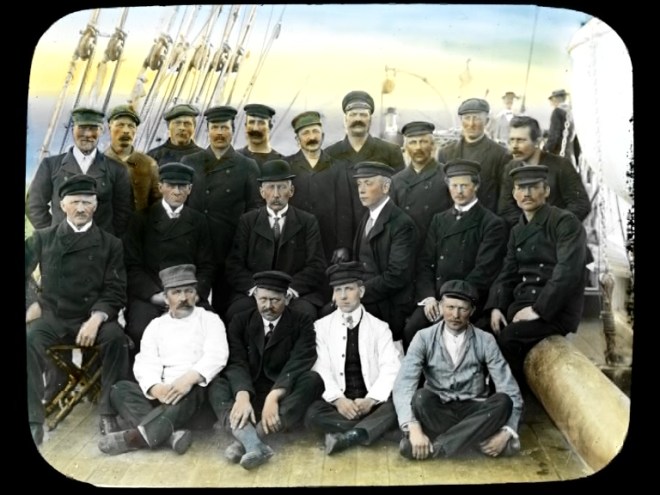
Usually, the silent films I review are pictures intended to be the star of the show or at least a supporting player. In the case of Roald Amundsen’s South Pole Journey, the footage was taken for the purpose of accompanying the explorer’s lectures and while the cut we will be viewing was meant for theatrical release, it does feel like something is missing. I highly recommend watching the film in tandem with reading a book about the expedition in order to derive maximum enjoyment.
Nobody is quite sure what led to Amundsen’s decision to take motion picture equipment with him the Antarctica. He might have been influenced by the multimedia lectures of fellow explorer Ernest Shackleton, whom he greatly admired. Or he might have been approached by director Hugo Hermansen, who acted as representative for Norsk Kinematograf Aktieselskab and to whom Amundsen granted distribution rights for his polar footage while reserving some material for use in lectures. (Amundsen’s lectures were supposed to be witty and interesting, I wish somebody had recorded them.) Also, we must remember that travel footage and actualities were extremely popular with all moviegoers, so Amundsen may have been inspired by them.
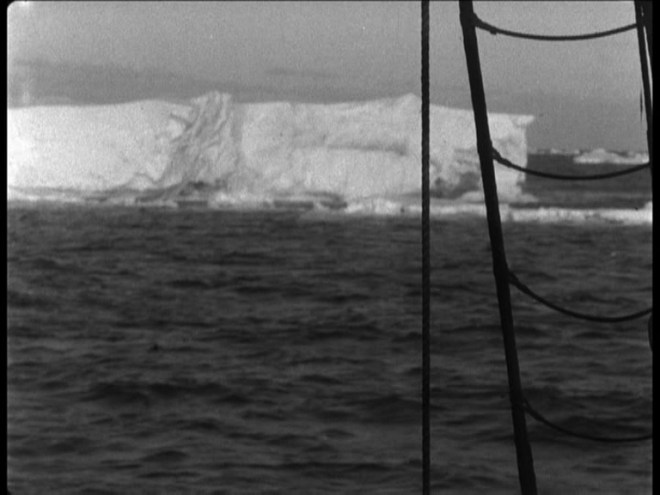
Amundsen himself acted as cameraman during the first leg of the journey, eventually turning the task over first mate Kristian Prestrud. (Amundsen’s rival to the Pole, Captain Scott, employed professional photographer Herbert Ponting to film his expedition and Shackleton would later hire Frank Hurley to record his doomed polar crossing, the footage of which would become South.) While the lack of professional cameramen on the Norwegian team leads to, perhaps, less dynamic footage, it is fascinating to think that these images were shot by the great explorers themselves. (That being said, Hurley’s footage is astonishing and South is a must-see.)
The Norwegian team had originally intended to make an attempt for the North Pole but upon hearing that Cook and Peary both claimed to have reached that goal, Amundsen switched his target south. (And only informed a few people of this fact.) Scott was making his own attempt for the Pole and Amundsen sent him a telegram from Madeira in 1910: “BEG TO INFORM YOU FRAM PROCEEDING ANTARCTIC–AMUNDSEN.”

The Fram referred to Amundsen’s ship, one of the first vessels designed and built specifically for polar exploration. It had been conceived by the legendary explorer and humanitarian Fridtjof Nansen and was a round, sturdy thing. The idea is that rather than be crushed by polar ice, it would pop out of the ice’s grip as it was “round and slippery as an eel.”
It’s worth remembering that at the time, Norway was not particularly wealthy and had only been its own independent country for a few years. Therefore, Norwegians of the time would have viewed themselves as the plucky underdogs and the British as the great and vast empire. They’re not wrong but it’s also worth remembering that the attitude in many countries was “Millions for defense, not one penny for exploration!” and so expedition leaders were obliged to raise money any way they could. Scott, Amundsen and Shackleton all relied on some combination of private donors, money from lectures, the sale of film rights and, if they could get them, government funds.
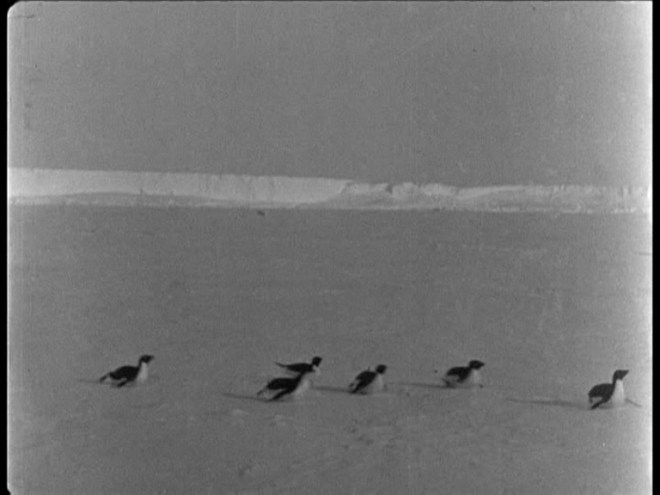
Amundsen’s South Pole Journey is designed for maximum audience appeal. And by that, I mean penguins. However, the film opens with a shot of the Fram all set for her voyage and then we see the Ross Sea, the Bay of Whales (with whale) and, of course, icebergs galore.
All polar films from this period had a slight element of the anticlimactic. There is no footage of the actual push for the Pole. Every ounce of weight was carefully accounted for and while still photography was seen as important for proving that the team had reached their goal, motion picture equipment would have been so much excess baggage that probably would not have worked in the extreme weather in any case.

Without a doubt, the most charming sequence in the presentation is the footage of the expedition’s engineer, Knut Sundbeck, befriending a penguin. He bows politely, the penguin is intrigued and then Sundbeck offers the bird a puff on his pipe. When the bird shies away, Sundbeck bows again and the game continues. The innocent delight that Sundbeck takes in interacting with the penguin is contagious and it is impossible to watch the scene without smiling. (The scene is described as a man with a solitary penguin but the scene descriptions for the English lecture version identify him as Sundbeck.)
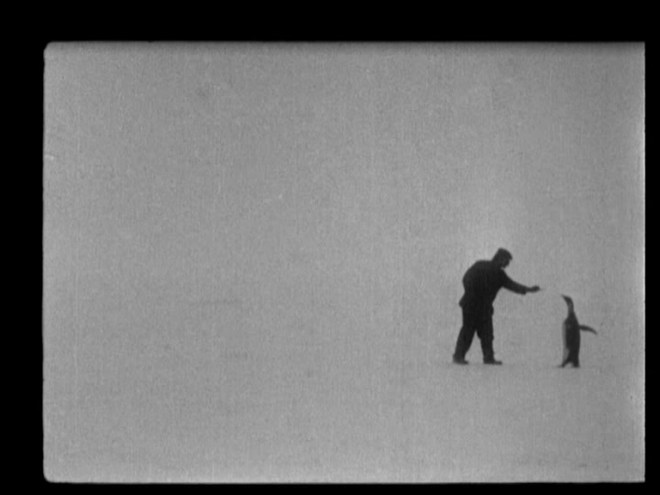
We also see what is described as dogs attacking a seal but I think their body language indicates play rather than attack. In any case, the seal easily frightens the dogs away. We are also shown Framheim, the team’s base camp, which consisted of constructed huts and tunnels in the snow and ice. Going underground proved to be a clever solution to the problem of being is close quarters during the long winter and I am sure the introverts on the team appreciated it.
There is also footage of Amundsen and his four man team departing for the Pole. Such shots are seen again and again in exploration/adventure footage. They are the last chance to see the adventurers before their hoped-for return and provide a haunting end if there is no return. (See The Epic of Everest for what is likely the most famous example.)
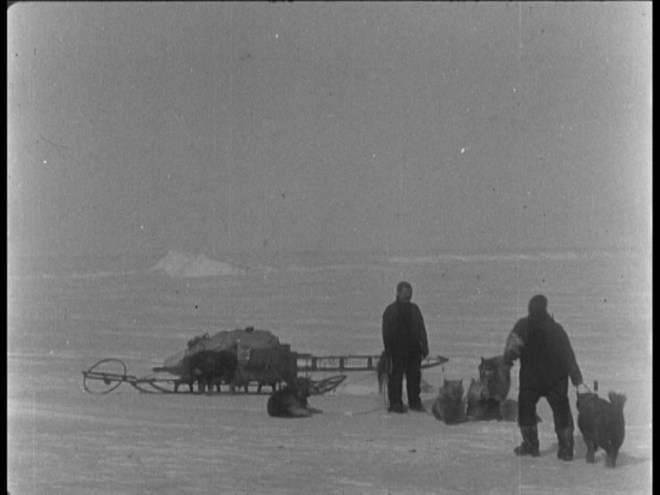
The bicycle wheel you see behind the sled was called a sledgemeter and was used to measure distance. Knowing one’s location was a matter of life or death on such a journey and the fine drift snow was getting inside the mechanism. The expedition’s cook, Adolf Lindstrøm, managed to solve this problem. Lindstrøm was universally popular for his skills as a cook, his value as a handyman and his cheerful disposition as unofficial morale officer. Most importantly, he was a master of warding off scurvy. (He was less adept as a cameraman as he took to cranking at a furious speed, which would have inadvertently created slow motion material. None of this footage seems to survive.)
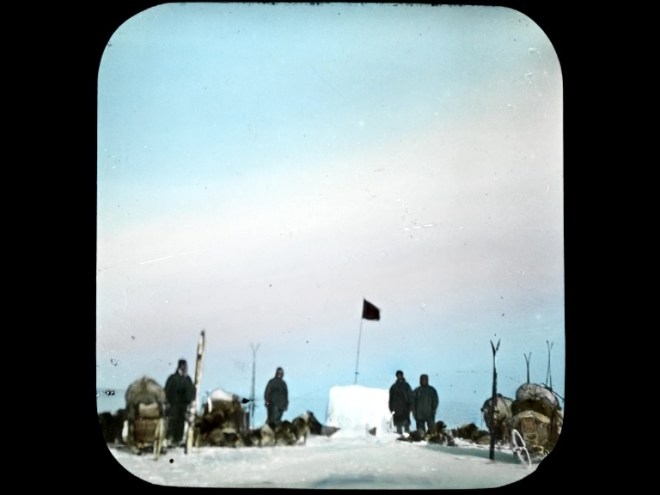
Food was of particular importance because the South Pole team would not only need fresh meat, it would also need other calorie dense foods. Chocolate, raisins, dried milk and biscuits were packed because they would provide a heap of calories in a small package. To increase efficiency, Amundsen refused to pack coffee or tea because they did not provide sufficient nutrition. I cannot imagine that this made him very popular.
About that fresh meat… We are shown the slaughtering of a pig and that’s where talk of meat ends in the film. As is the case with all polar films, the cinematic cut shows the cute dogs and seals but are not told in the titles that all would end up as food at some point. However, the Nasjonalbiblioteket release of the polar footage includes the text of one of Amundsen’s lectures thoughtfully translated into English and he mentions using the dogs for both transport and as a food source, as well as hunting seals for their meat. (He was also not shy about bringing this up in his diary.)

In my research for this piece, I noticed quite a few complaints about Amundsen eating dog. I’ll just mention that Scott shot his ponies, including an adorable little scamp named Christopher, as dog food but the humans soon partook of the meat as well. (Per Scott: “We have all taken to horse meat and are so well fed that hunger isn’t thought of.”) If there was ever a time to look at context, this is it. I don’t like the idea of animals being hurt either but the trigger warning above is in place for a reason. The South Pole was not a nice place, fresh meat provided much-needed vitamin C and there were no butcher shops at the bottom of the globe. If you want to debate the ethics of this (somewhere else, please), fine, but it’s disingenuous to single Amundsen out.

Amundsen had researched extensively and had taken advice from the indigenous peoples of the far north, basing his team’s outfits on traditional Inuit designs. He also made sure that his voyage was oversupplied with food, clothing and fuel. (His team solved the problem of evaporating paraffin, which was important for warmth and cooking but also as a way to melt snow and prevent dehydration.) He also scheduled his run to the Pole so as not to exhaust his team, keeping everyone well within their safe limits and resting often.
Amundsen’s goal from the start was to recruit men who were talented in their fields and who would get along and work well together. However, Amundsen himself had a streak of coldness that would cause a tragedy. Hjalmar Johansen was an explorer and companion to Fridtjof Nansen but he was never quite the same after he came home. As a favor, Nansen asked Amundsen to take Johansen along on his latest voyage and Amundsen reluctantly disagreed.
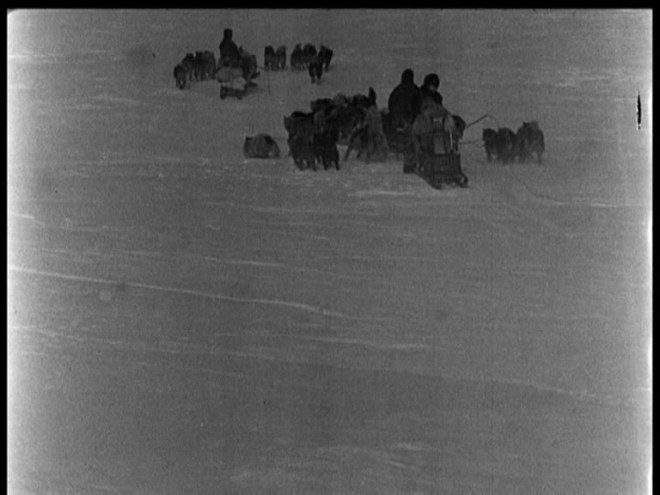
Johansen made no secret of the fact that he thought Amundsen was inferior to Nansen and things came to a head during the group’s aborted first attempt at the Pole. Amundsen left too early, the weather was too severe, the team was forced to retreat to Framheim and Johansen openly lashed out. As a result, Amundsen removed Johansen from his polar team and sent him on a lesser mission of exploration.
The Johansen incident does not reflect well on Amundsen. True, losing one’s temper at the boss is not generally a good idea but there were extenuating circumstances. Amundsen did leave too early; he would have left even earlier if his crew had not put their feet down. Further, Johansen’s mental condition was fragile and should have been considered before applying disciplinary measures. (Psychology was still a relatively new field but Johansen’s state was well known among his companions and Nansen had asked Amundsen to take him along in hope that it would help him find some measure of peace.) The fact that Johansen committed suicide after his return to Norway is a dark and tragic coda to the Fram expedition.
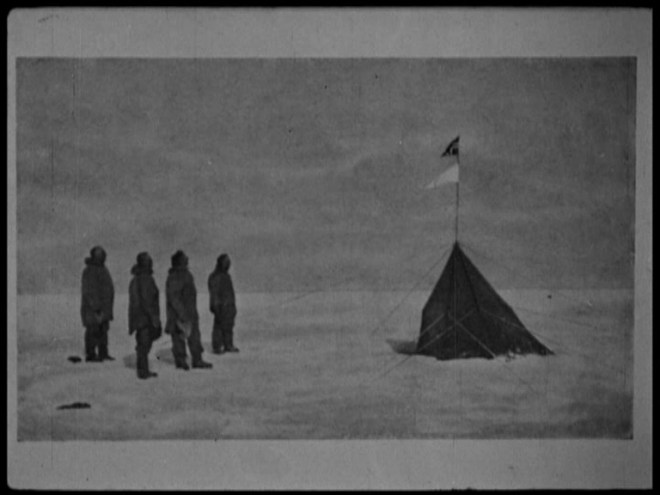
Amundsen profited from the lessons learned on the aborted trip and made final tweaks to the equipment. He set out for the Pole on September 8, 1911 and was accompanied by Bjaaland, Helmer Hanssen, Sverre Hassel and Oscar Wisting. They reached the South Pole on December 14 and returned to Framheim on January 25, 1912. Not a single man was lost.
And now we come to the part of the review that is sure to ruffle feathers. Comparisons between Scott and Amundsen are inevitable and are enthusiastically debated with vigor usually reserved for discussion board battles over whether a Borg cube can defeat an Imperial Star Destroyer. I won’t be going too heavily into Scott’s doomed expedition as I am going to be reviewing footage of it soon but I will address a charge that is commonly leveled at Amundsen.

The notion that Amundsen’s secrecy made him a “foreign bounder” who sneakily maneuvered his South Pole run behind Scott’s back was a fairly popular interpretation for a time and still crops up today. (Never mind the fact that Scott was just as foreign to the uninhabited chunk of ice as Amundsen.) In fact, Amudsen’s secrecy likely had much more to do with his desire to prevent any objections from the Norwegian government or from Nansen for his use of the Fram, not to mention the issue of creditors and backers who fully expected him to head north. According to his journals, Amundsen made his decision to head south on Thursday, September 9, 1909 and Scott did not announce his intentions until the following Monday.
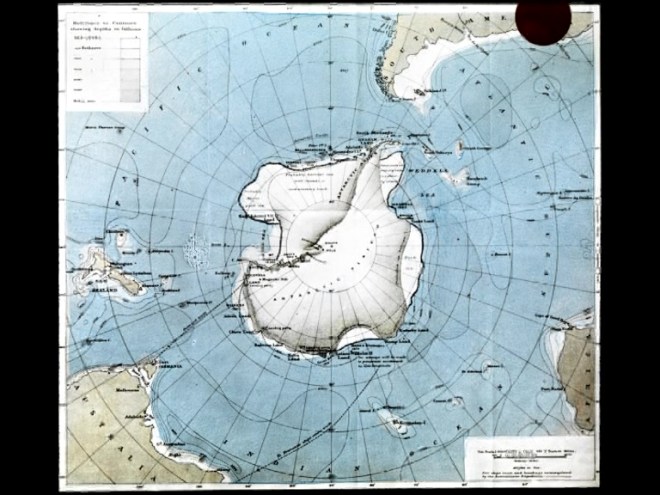
Further, both Scott and Amundsen were spurred on by Shackleton’s record-setting attempt at the pole and by the threat of other nations fielding their own polar exploration teams. Neither men were saints, nor were they demons but Scott certainly got the better end of the adoration deal for a good stretch, which is really a cartoonish interpretation of the events.
As Captain Lawrence Oates, one of the men Scott chose to accompany him to the Pole, wrote to his mother when was confirmed that Amundsen meant to make for the pole: “They say Amundsen has been underhand but I do not personally see it is underhand to keep your mouth shut.”

Still, Oates seems to have been in the minority. The Daily Mail (of course) sniffed that, according to “the rules of Polar etiquette” Amundsen was required to stay out of Scott’s sphere i.e. the South Pole. I just love it when people create rules out of thin air that only benefit them or their side and proclaim that everyone else must follow them. Scott wrote in his diary that he felt Amundsen arriving at the Pole in December was in response to Scott himself aiming to arrive pre-Christmas 1911. (It’s a moot point as Scott did not reach the Pole until January 17, 1912.)
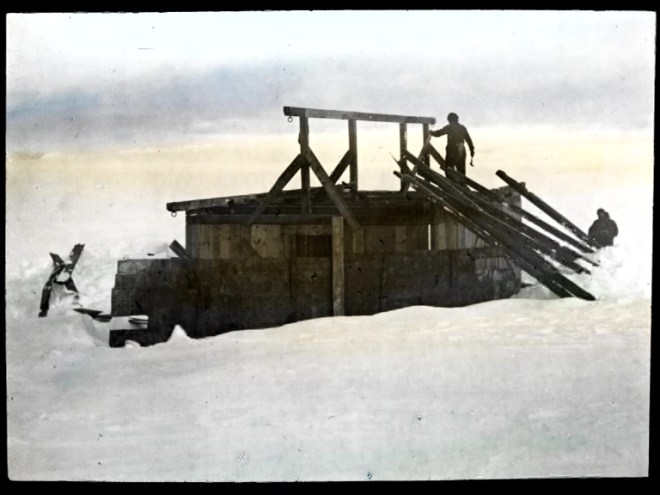
Apsley Cherry-Garrard, who was part of Scott’s team, later wrote in The Worst Journey in the World that: “On the one hand, Amundsen going straight there, getting there first, and returning without the loss of a single man, and without having put any greater strain on himself and his men than was all in the day’s work of polar exploration. Nothing more business-like could be imagined. On the other hand, our expedition, running appalling risks, performing prodigies of superhuman endurance, achieving immortal renown, commemorated in august cathedral sermons and by public statues, yet reaching the Pole only to find our terrible journey superfluous, and leaving our best men dead on the ice.” Cherry-Garrard goes on a bit with the “foreign bounder” narrative and then states that: “We were primarily a great scientific expedition, with the Pole as our bait for public support, though it was not more important than any other acre of the plateau.”
(So, um, why would they be so upset about arriving second to the Pole if such was the case? This is the very definition of sour grapes. “We never wanted it in the first place!”)

The “all for science!” defense is still common but ignores the fact that the portion of the Norwegian team left in Framheim continued their own charting and mapping and research, in addition to tinkering with and improving arctic gear. They just didn’t plunk rocks into their sleds when their lives depended on speed. Further, Amundsen’s very trip was scientific research as he was blazing an entirely new trail while Scott was following Shackleton’s maps.
The belief that Scott was owed the Pole has diminished but still survives in modern times. Polar expert Nick Cox even goes so far as to directly blame the Norwegians for Scott’s death. “Amundsen would not have lied and headed south,” says Cox. “Scott would not have got to the South Pole any quicker, but his party’s return – having been first to the pole – would have been a far more spirited, cheerful affair. Scott, Bowers and Wilson died 11 miles short of a huge food depot. They just might have made that with the spring of victory in their steps.”
You know what else would have put a spring in Scott’s step? Practicing skiing before leaving for the Pole.

I am inclined to give Cherry-Garrard a pass because he was part of the team that found the bodies of Scott and his companions (which included his very close friend, Dr. Bill Wilson) and was carrying guilt about a failed rendezvous but modern writers have no such excuse and the entitlement is absolutely infuriating. Scott also pulled his ridiculous “MINE, MINE, MINE!!!” routine with Shackleton, far beyond the bounds of “polar etiquette” so this was by no means an isolated incident. This is doubly ridiculous because Fridtjof Nansen had been more than generous to Scott with his time, knowledge and advice.
“Amundsen should have let Scott win!” seems a bizarre stretch of ice to die on but there we have it. Rather than being known as a bungler, some of Scott’s supporters seem to want to paint him as a buffoonishly fragile martyr done in because the mean Norwegians wouldn’t let him win. With defenders like these, Scott doesn’t need enemies. (For the record, I find Scott to be a far more complicated person than either his detractors or defenders generally allow.)

While there certainly were mistakes made on the Amundsen expedition, the whole enterprise is notable for the remarkable planning and impressive talents of the crew. Hardworking, smart and, if anything, overqualified, they were quick to learn and improve throughout the journey. They, more than any other factor, were responsible for Amundsen attaining the pole and it’s a pleasure to see them in action. (Needless to say, I am very much looking forward to the newly-announced Amundsen biopic in the works.)
After it was clear that Amundsen had won the race to the pole, Scott wrote that the Norwegian must have found an easy way and the image of the British team bravely tramping on foot while the Norwegians rode in sleds (and presumably munched bonbons) has been another line of attack. In fact, the Norwegian climate and culture (particularly its skiing culture) prepared the Norwegian team, as well as the careful planning and tweaking described above, and they did not have it easy by any stretch of the imagination as they crossed completely uncharted and unmapped territory.
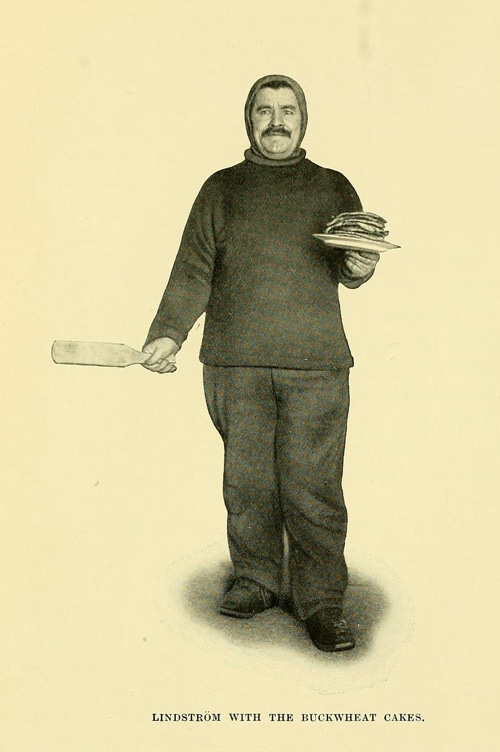
To put the success of the Fram team’s expedition down to mere good luck is slightly insulting considering all the sweat and brain cells that were expended to make the polar attempt a success. As Fridtjof Nansen put it, “Amundsen’s luck is the strong man’s luck, the foresighted man’s luck.” And, I might add, the “luck” of a qualified team of professionals.
Roald Amundsen’s South Pole Journey is not as polished as other polar films but it showcases the team and is a priceless record of their achievement.
Where can I see it?
The DVD released by Nasjonalbiblioteket does not seem to be readily available in North America but you can contact them directly for a copy. The museum has also made Roald Amundsen’s South Pole Journey available for free and legal viewing on their official YouTube Channel.
***
Like what you’re reading? Please consider sponsoring me on Patreon. All patrons will get early previews of upcoming features, exclusive polls and other goodies.
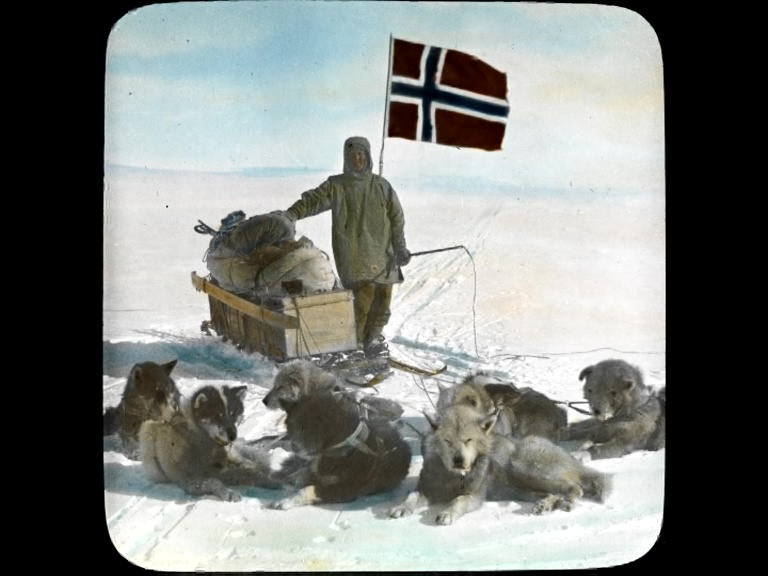
The images alone take my breath away! Thank you, thank you, thank you for this in-depth review! Now off to youtube to watch Roald Amundsen’s South Pole Journey 😀
Enjoy! The film has a wonderful, homespun charm. 🙂
Wow–had no idea of the rivalry between Amundsen and Scott fans! People will find a way to argue about anything. Beautiful images either way.
Most people I know take the alternate route and are Team Shackleton. 😉 Yes, some amazing shots, especially considering that they were not professional cameramen.
Thank You for a wonderful review, that is also enlightening!
It’s amazing the phony narratives that can be created, and believed.
I’m looking forward to watching this one.
Thanks so much! Yes, it is amazing the mental gymnastics involved in order to absolve Scott of all blame.
Just watched it- remarkable throughout! Particularly like Sundbeck’s meet up with the tall penguin. That penguin’s status must have been top-of-the-heap when it got back to the group…”I let that whatever-he-was near me in case he had any fish to offer. His “fish” smelled awful, so I rejected it. Pew!” Tall Penguin is then proclaimed Penguin Ruler of the South Pole by all his fellows 😉
How did they keep the film and camera from freezing up in that months-long frigid environment, I can’t help but wonder…?
I second the nomination!
Unfortunately, Amundsen writes very little about his motion picture camera and I am not even sure what make he used but I do know that all the footage was taken during the warmer months in Antarctica.
P.S. Here is some info on Ponting’s cold weather woes.
http://www.stuff.co.nz/the-press/entertainment/christchurch-arts/4020000/Adventurers-on-the-Ice
Warmer months in Antarctica, particularly along the coastline, much better than winter, spring, or fall, it appears. But still…
Thanks for the Ponting and Hurley info link. Can’t begin to fathom dealing with glass plate negatives in those circumstances, so hats off to these two intrepid gentlemen!
Thanks for posting this review! I did a school project on Roald Amundsen, about 35 years ago and have been fascinated by him since.
I know you say it’s difficult to get, but I would love a copy of the DVD set. Can you point me in the right direction towards purchasing one?
I’m really sorry but I don’t know of a way to get it outside of Norway. It’s available for sale at the Nasjonalbiblioteket so perhaps you can contact them?
https://www.nb.no/english
Thank you! I will contact them and see if it’s possible.
And thank you for the YouTube link, at least I will be able to check it out.
Dang, I knew most of Amundsen’s still photos didn’t really come out (getting good with the camera seems to be the only thing he didn’t prepare for). But I didn’t realize there was this much moving film of the base etc. Gonna have to look that up.
There will ALWAYS be people defending Scott’s terrible planning (which cost him far more than bad luck). Scott PLANNED to be out on the trail in March when Shackleton’s near miss had barely made it back in mid Feb (and been given up for dead). As it was, with a little more bad luck, his expedition could easily have lost 9 more men that winter. The Northern party lived out the winter in an ice cave when the ship couldn’t reach them and the supporting party made it back by heroism (the P.O.s wouldn’t abandon their commander) and some lucky breaks.
I’ve come to think better of Scott from a distance. This is a man who grabbed his one chance at the brass ring (getting effectively promoted 2 ranks in a rather stalled navy career when he didn’t have backers or a famous name). Then he finds that he has effectively been elected designated national hero, and has to do the rest of the journey at some point (and the world isn’t waiting for him to make admiral). Amundsen and Shackleton were willing to be completely honest about the whole point of the trip. Scott had to talk around it (because his “Establishment” backing would have found it crude to say such things, but he knew he had to get there anyway. I admire Shackles and Amundsen, but I see how monomaniacal they were and how that lead to them having frightful arguments with others. Scott is different, I think I understand how he got where he did, and I feel a sort of pity for him (but not of the quality I reserve for those who had to depend on his judgement.
There’s actually quite a bit more. The DVD includes about 40 minutes of unedited footage as well. There are no big revelations in the material but it is fascinating to look at.
Scott was absolutely a product of his time and for that reason, his peculiar brand of heroism has not weathered as well as the “everyone gets out alive” work of Shackleton and Amundsen. There was definitely an element of competition with Shackleton in the polar journey, Scott’s diaries showcase an absolute obsession (Shackleton exaggerated the weather here, our ponies are better than Shackleton’s, Shackleton had more or less snow).
I do think that Scott’s critics go a bit far in the personal attacks because, whatever his flaws, he did inspire extreme loyalty among his men. His biggest issue was really his obvious love of flying by the seat of his trousers and improvising on the fly. (He lavishly praised PO Evans for being able to rework a sledge on the trail, for example.) While innovation was certainly needed, Amundsen for the most part confined his to base camp and its environs and Scott set out on his journey without being certain of the motor sledges or the ponies. Really, it was death by a thousand cuts: dozens of terrible small decisions that combined to create disaster.
The thing that humanizes Scott for me is realizing how out of his depth he was being “THE MAN”. He wasn’t from the sort of family that normally got the sort of Patronage assignment like Polar exploration (most of the Northwest Passage etc. stuff was an excuse/opportunity to decorate/promote officers during the long peace after Napoleon). With the Royal navy growing at breakneck speed (something like 25% of the officers of Scott’s year made admiral, a HUGE percentage), you didn’t need to go to the ends of the earth to get promoted. Scott took an opportunity that wouldn’t have been his 20 years before and sort of found himself tied to being a polar hero.
This is probably what made him impossible to argue with (Shackles and Amundsen could be argued with, within certain limits). He had to stand on rank too much (which is probably part of what Oates and Meares didn’t like about him).
I think it’s important to see Scott as a man but one with major blinders and curiously uninterested in the actual nuts and bolts of his exploration in many cases. The motor sledges are a prime example as they did not perform well during the depot run and they didn’t perform well when they were used again. His expedition was an unfortunate combination of Navy rigidity and absolute amateur hour. Many of his woes were not his fault (the weather, the new theory that scurvy was caused by bad canned goods and not a lack of fresh veggies) but enough were. The main task I am going to tackle is acknowledge Scott’s humanity while also being very clear about his faults.
Hi everybody,
For anyone that’s interested, I did contact the Nasjonalbiblioteket about obtaining the DVD.
They kindly got right back to me and a copy of the DVD is on its way! The cost is only 99 Norwegian Krones, which seems like a lot, but ended up only being just over $16 (Canadian dollars, because that’s where I am!). And they didn’t charge for shipping, either!
Thanks again, Fritzi, for the contact info and for providing this great site for silent film fans!
Excellent to hear! I’ll put a link in the review itself in case anybody else wants to get a copy.
Thanks, great idea!
Great article! I’m a passing fan of polar exploration stuff, but I had never seen most of those images before. Beautiful! And I totally don’t get the Amundsen vs Scott rivalry thing. While I agree that Amundsen seemed to be better prepared, I believe that both men and their teams deserve mad props for simply setting out on such an expedition. I’m sure most of the folks who deride either of the men would never attempt a south pole trip themselves, even with today’s relative comforts and technology.
I think a lot of it started after the world learned of Scott’s death and they quickly painted Amundsen as the villainous “chancer” who scooped up the Pole right out from under Scott. If you read articles on the expedition, particularly in larger outlets, you will see the Scott Brigade show up in force with complaints about dog eating, lack of sciencey stuff, etc. It’s bizarre.
DVD arrived yesterday, can’t wait to check it out! Thanks again for the heads up on this one, Fritzi!